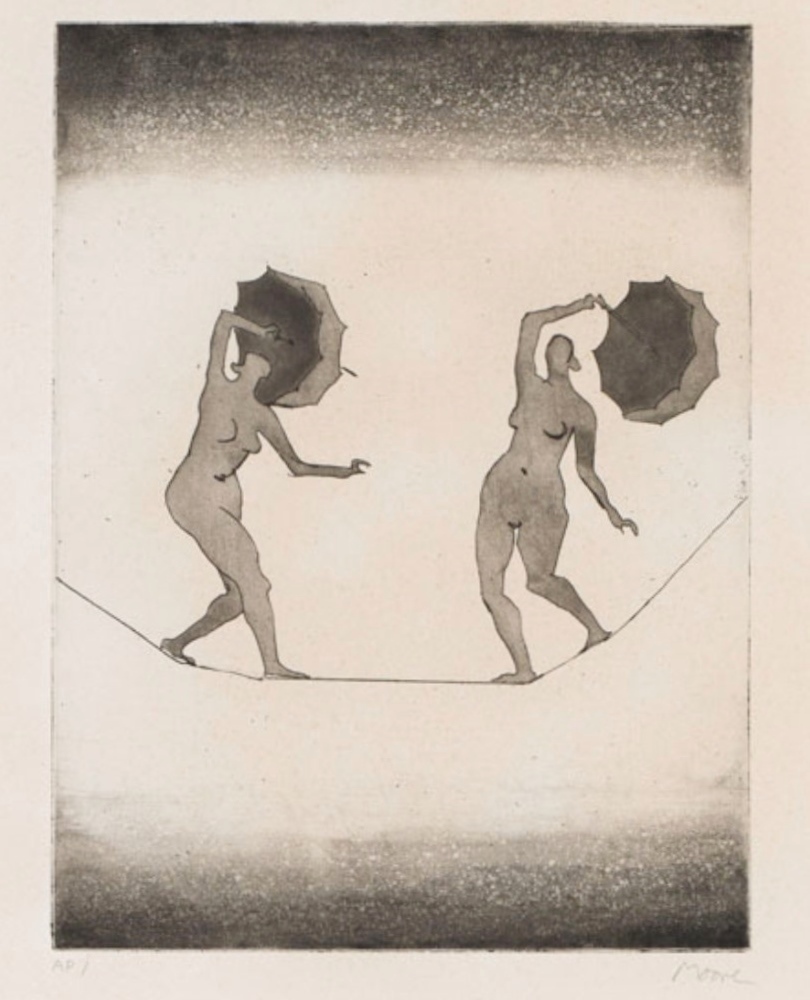Etching and aquatint on paper by Henry Moore – Titled: High line walkers, 1975
Original limited edition fine art print by Henry Moore – Titled: High Line Walkers, 1975 (Circus acts series)
Etching and aquatint on paper signed in pencil on lower right by the artist and justified and numbered on lower left in pencil. One of an edition 75 signed and numbered etchings aside like this one, circa 10 AP (Artist proofs) and a few H.C.
Not framed
Dimensions: 24.8 x 19 cm – 9.75 x 7.5 in.
Printer: Basis.
Publisher: Ganymed & Fischer Fine Art
Published References : Henry Moore: Prints and Portfolios – Henry Moore: Catalogue of Graphic Work, Volume 3, 1976-1979, by Patrick Cramer, Alistair Grant and David Mitchinson.
Price: Contact gallery for more information on artwork or on artist.
See more Intaglio printings >>
See more fine art prints>>
Henry MOORE (1898 – 1986)
Henry Spencer Moore aka Henry Moore, was born July 30, 1898 in Castleford, Yorkshire and died August 31, 1986 in Much Hadham, Hertfordshire, he is a British sculptor.
From a family of miners, he became famous thanks to his large abstract sculptures in bronze and carved marble. Strongly supported by the British artistic community, Moore helped to introduce a particular form of modernism to the United Kingdom, drawing inspiration from the so-called primitive styles of ancient civilizations such as the Minoan, Assyrian, Babylonian, Romano-Gothic styles observed in the British Museum, and later, Mayan art.
In 1921, Moore obtained a scholarship to study sculpture at the Royal College of Art (RCA) in London. Delighted not to have studied in a school of fine arts before his twenty-first year, he passes a very severe judgment on the closed perspectives of academicism: “whatever enthusiasm, whatever freshness they may have had” very quickly it extinguished or ended up disappearing in the routine practice of copies after the antique, of carefully shaded drawings, without their having the slightest knowledge of the form.
His talent was recognized in 1950’s, when he was appointed honorary doctorate in a large number of universities around the world. His works reached a very high price on the world market as soon as Sotheby’s and Christie’s were able to resume their normal activities after the war in London and New York. However, Moore lived modestly, and most of his fortune went to the Henry Moore Foundation, which continues to support artistic education and promotion.
Most of his sculptures represent a reclining figure, often female, sometimes pierced with a circle in the body especially from the 1960s. Moore was inspired by Toltec art – notably by a Mayan sculpture known as ” Chac Mool ”, of which he saw a plaster reproduction in Paris in 1925. More and more monumental, more and more abstract, sometimes disarticulated, the artist’s sculptures have been the subject of official orders, notably the Unique Mountain of the City Center of Dallas, bronze over 12 m, also known as the Dallas Piece.
Moore also produced a large number of drawings, some collected in notebooks, the most famous of which is the Vault Notebook, kept in the British Museum, the drawings of which were made in the shelters during the bombing of London.
Moore’s printmaking corpus.
Moore always strives to develop a universal visual language from elementary forms. In his last years especially, we see emerging in his work an important set of more than 700 lithographs and engravings. His creation then shifts from sculpture to engraving and printmaking; this is probably due to the fact that the artist’s physical strengths decline with age, but it takes nothing away at all of its importance. This graphic production enabled Moore to invent a new artistic freedom for himself outside of his sculptural works. The themes in his graphic works are mostly figurative: figures, characters in different poses, mother and child, landscapes, animals, monuments, structures and bones. In his early works, he started with sketches to develop new sculptures; in the 1960s and 1970s, he developed ideas for sculptures in drawings or engravings without necessarily wanting to go to the stage of realization. He is content to test their effect graphically and forgo really locating them in space.
Moore’s interest in natural forms, such as bones, is again reflected in later lithographs and sculptures. If they interest him so much, it is also because they outline an internal structure that determines the external form. He wanted the force contained within to put pressure on the outside.
#Biography – Sources: Wikipedia and Archives : Ysebaert Louisseize Arts
+++
Date:
December 6, 2020
See more artworks and bio of
AA-Graphic arts